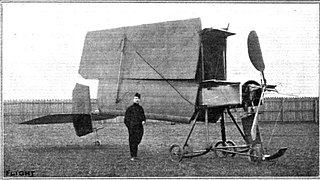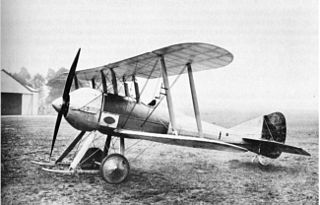
The Avro 504 was a First World War biplane aircraft made by the Avro aircraft company and under licence by others. Production during the war totalled 8,970 and continued for almost 20 years, making it the most-produced aircraft of any kind that served in any military capacity during the First World War. More than 10,000 were built from 1913 until production ended in 1932.

The Short L.17 Scylla was a British four-engined 39-seat biplane airliner designed and built by Short Brothers at the request of Imperial Airways to supplement the Handley Page H.P.42 fleet already in service after Handley Page quoted an excessive price for two additional H.P.42s. They were ordered in 1933.
The Bristol Biplane Type 'T', sometimes called the Challenger-Dickson Biplane, was a derivative of the Bristol Boxkite. It was built in 1911 by the British and Colonial Aeroplane Company and was designed as a cross-country racing aircraft for Maurice Tabuteau.

The Roe I Biplane was the first powered aircraft to be designed, built, and flown in England. Designed in an attempt to claim a prize offered by the Brooklands Automobile Racing Club, it was designed and built by Alliott Verdon Roe, who based it on a powered model with which he had won a Daily Mail prize of £75 at Alexandra Palace in April 1907. This prize was substantially larger: the club committee was offering £2,500 for the first person to fly a circuit of their three-mile (4.8 km) race track by the end of the year. In addition the Daily Graphic was offering a £1,000 prize for a flight of more than a mile (1.6 km).

The Roe I Triplane was an early aircraft designed and built by A.V. Roe which was the first all-British aircraft to fly..

The Roe IV Triplane was an early British aircraft designed by Alliott Verdon Roe and built by A.V. Roe and Company. It was first flown in September 1910.

The Avro Type D was an aircraft built in 1911 by the pioneer British aircraft designer A.V. Roe. Roe had previously built and flown several aircraft at Brooklands, most being tractor layout triplanes. The Type D was his first biplane.

The Avro 534 Baby was a British single-seat light sporting biplane built shortly after the First World War.

The Bréguet Type III was an early biplane built by Louis Bréguet in France in 1910.

The Bristol Gordon England biplanes were a series of early British military biplane aircraft designed by Eric Gordon England for the Bristol Aeroplane Company that first flew in 1912. Designed for easy ground transport, the aircraft could be quickly disassembled.
The Sopwith Two-Seat Scout was a 1910s British biplane Anti-Zeppelin scout biplane designed and built for the Admiralty by the Sopwith Aviation Company. It was nicknamed the Spinning Jenny due to a tendency to enter a spin.

The Potez 32 and its military version the Potez 33 was a single-engine French monoplane transport built by Potez and based on the Potez 29 biplane.

The de Havilland DH.27 Derby was a large single-engined biplane designed to a heavy day bomber Air Ministry specification. It did not reach production.

The Royal Aircraft Factory S.E.2 was an early British single-seat scout aircraft. Designed and built at the Royal Aircraft Factory in 1912–13 as the B.S.1, the prototype was rebuilt several times before serving with the Royal Flying Corps over the Western Front in the early months of the First World War.
The Sopwith Admiralty Types 137 and 138 were a pair of single-engine, two-seat naval biplane floatplanes, built to a British Admiralty order in 1914. They were similar in design, but having a more powerful engine the Type 138 was the larger and heavier. They were used in early torpedo dropping experiments in 1914.

The ASL Viking was a single-engined two seater biplane aircraft designed and built by Horatio Barber's Aeronautical Syndicate Ltd. at Hendon. It was first flown in January 1912.

The Short S.36 was a British two-seat tractor biplane, built by Short Brothers for Francis McClean in 1911. It was later developed into the Short S.41 and Short S.45, which were the first of a long series of similar aircraft built for the RNAS and RFC.
The Gabardini biplane was an Italian single seat biplane, designed and built near the beginning of World War I. It was an advanced trainer and could be fitted with engines of output between about 40 to 80 kW.
The Caudron 02 was a French high altitude single seat fighter that was flown in November 1917.
The Tokyo Koku Aiba-Tsubame or Tokyo Aviation Aiba-Swallow was a 1930s Japanese civil transport with seats for three passengers. It was intended to be cheap to produce so, although its fuselage was a new design, its wings and undercarriage were those of another Japanese aircraft. Two were built and flew taxi services and joyrides.
















